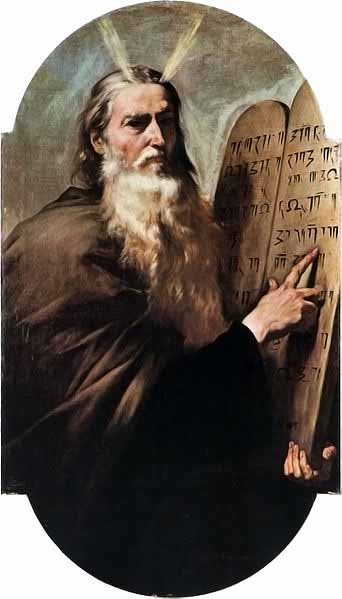


�Exodus 34:29-35 tells that after meeting with God the skin of Moses' face became radiant, frightening the Israelites and leading Moses to wear a veil. Jonathan Kirsch, in his book Moses: A Life, thought that, since he subsequently had to wear a veil to hide it, Moses' face was disfigured by a sort of "divine radiation burn". Interpreted correctly, these two words form an expression meaning that Moses was enlightened, that "the skin of his face shone" (as with a gloriole), as the KJV has it.
The Septuagint properly translates the Hebrew phrase as, "his face was glorified"; but Jerome translated the phrase into Latin as cornuta esset facies sua "his face was horned". With apparent Biblical authority, and the added convenience of giving Moses a unique and easily identifiable visual attribute (something the other Old Testament prophets notably lacked), it remained standard in Western art to depict Moses with small horns until well after the mistranslation was realized by the Renaissance. Michelangelo's Moses, is probably the best-known example.
Not all the Renaissance Italian painters gave horns to Moses. The Venetian artist Tintoretto depicts Moses' face as radiating light, in his series about the life of the prophet in the Scuola di San Rocco.

depicted as a dark skin male.


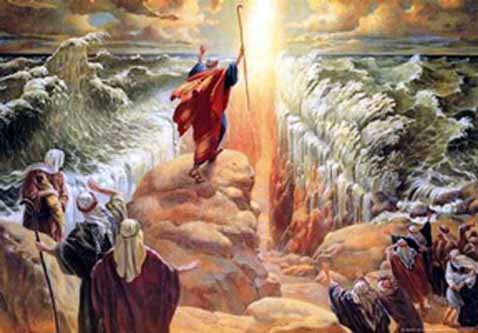
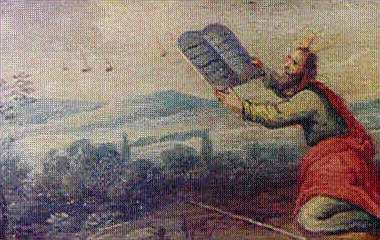
In this painting found on a wood drawer from furniture kept at the Earls D'Oltremond, in Belgium, Moses is depicted receiving the tablets of the Ten Commandments, with "flaming horns." Several equally flaming objects are in the sky before him. The date and artist are unknown.

Moses comes from the ancient Hebrew bloodline whose roots go back to creation and are linked with Ancient Alien Theory. His belief in Monotheism - one God of Light symbolized by a sacred flame - again shows him as Pharaoh Akhenaten and Zoroaster, all aliens, along with the story of Jesus. This dates back to the teachings of the ancient Egyptian Priests and the Mystery School Teachings which were about Creation as a Consciousness Hologram. It's all about alchemy.

The Alchemist and the Symbols

Skeptical historians, generally called Biblical Minimalists, suggest that Moses never actually existed as a historical figure, and that the Exodus is a myth. Historical records are so fragmentary that extra-biblical records of Moses may have been long lost. For example, if the Exodus occurred during the end of the Hyksos era in Egypt (16th century BC), as some scholars believe, then any Hyksos records of Moses would have been deliberately destroyed by victorious Egyptians as they drove the Hyksos out of Egypt.
Destruction of unfavorable records by unsympathetic Pharaohs, and even mass obliteration of cartouches from monuments, is known to have occurred at several epochs in Ancient Egyptian history.
Known extra-biblical references to Moses date from many centuries after his supposed lifetime. Whether or not they are reliant on Jewish tradition or also have access to additional sources is unknown. Polyhistor, Flavius Josephus, Philo, and Manetho refer to him, as do others. Also, of course, there are the above-mentioned stories in the Mishna and Qur'an.
In the 3rd century BC, Manetho, a Hellenistic Egyptian chronicler and priest, alleged that Moses was not a Jew, but an Egyptian renegade priest, called Osarseph, and portrayed the Exodus as the expulsion of a leper colony. A similar assertion is made by the Roman historian Tacitus in the Book 5 of his Histories.
Even if Moses is accepted as a historical figure, various aspects of the Biblical tale can be re-interpreted. Manetho's claim that Moses was an Egyptian is quite plausible.
It has been suggested that he may have been an Egyptian nobleman or prince influenced by the religion of Aten, or simply sympathetic to Hebrew culture. Moses is an Egyptian name-element meaning "-gave birth to him" or "-formed him" and was usually combined with a theophoric element, as in "Ramose" which had the meaning "child of Ra" or "Ra formed him".
Details about the life and times of Moses, as with others in ancient times, may or may not be entirely accurate. The dates of Moses's birth and death are hard to establish. Many contemporary authorities believe that the exodus took place in the 13th century BC.
As the story goes ...
Moses was, according to the Hebrew Bible and Qur'an, a religious leader, lawgiver and prophet, to whom the authorship of the Torah is traditionally attributed. Also called Moshe Rabbenu in Hebrew ("Moses our Teacher/Rabbi"), he is the most important prophet in Judaism, and is also considered an important prophet in Christianity and Islam, as well as a number of other faiths.
The existence of Moses as well as the veracity of the Exodus story is disputed amongst archaeologists and Egyptologists, with experts in the field of biblical criticism citing logical inconsistencies, new archaeological evidence, historical evidence, and related origin myths in Canaanite culture. Other historians maintain that the biographical details, and Egyptian background, attributed to Moses imply the existence of a historical political and religious leader who was involved in the consolidation of the Hebrew tribes in Canaan towards the end of the Bronze Age.
According to the Book of Exodus, Moses was born in a time when his people, the Children of Israel, were increasing in number and the Egyptian Pharaoh was worried that they might help Egypt's enemies. Moses' Hebrew mother, Jochebed, hides him when the Pharaoh ordered all newborn Hebrew boys to be killed, and the child is adopted as a foundling by the Egyptian royal family. After killing an Egyptian slave-master, Moses flees across the Red Sea to Midian where he has his encounter with the God of Israel in the form of the "burning bush". God sends Moses to request the release of the Israelites. After the Ten Plagues, Moses leads the Exodus of the Israelites out of Egypt and across the Red Sea, after which they base themselves at Mount Sinai, where Moses receives the Ten Commandments. After 40 years of wandering in the desert, Moses dies aged 120, within sight of the Promised Land.
Rabbinical Judaism calculated a lifespan of Moses corresponding to 1391-1271 BCE; Christian tradition has tended to assume an earlier date.
Moses was the son of Amram and his wife, Jochebed, a Levite. He is known as the legendary Hebrew liberator, leader, lawgiver, prophet, historian, and founder of Israel, or the Jewish people.
According to the Hebrew Bible, Moses led the Israelites out of slavery in Egypt and into the desert, and received the Torah of Judaism from God on Mount Sinai. The Torah contains the life story of Moses and his people until his death at the age of 120 years, according to Jewish count was in the year 2488, or 1272 BCE. Arising in part from his age, but also because 120 is elsewhere stated as the maximum age for Noah's descendants (Genesis 6:3), "may you live to 120" has become a common blessing among Jews.
Moses's greatest legacy was probably expounding the doctrine of monotheism, which was not widely accepted at the time, codifying it in Jewish religion with the 1st Commandment, and punishing polytheists. He is considered a prophet in Judaism, Christianity, and Islam.
The birth of Moses occurred at a time when the current Egyptian Pharaoh had commanded that all male children born to Hebrew slaves should be killed by drowning in the Nile river. The Torah leaves the identity of this Pharaoh unstated. But he is believed by some to be Ramses II; other, earlier pharaohs have also been suggested including a Hyksos pharaoh or one shortly after the Hyksos had been expelled.

Jochebed, the wife of the Levite Amram, bore a son, and kept him concealed for three months. When she could keep him hidden no longer, rather than deliver him to be killed, she set him adrift on the Nile river in a small craft of bulrushes coated in pitch. The daughter of Pharaoh discovered the baby and adopted him as her son, and named him "Moses" (considered to mean "to draw out"). By Biblical account, Moses' sister Miriam observed the progress of the tiny boat. Miriam then asked Pharaoh's daughter if she would like a Hebrew woman to nurse the baby.
Thereafter, Jochebed was employed as the child's nurse, and he grew and was brought to Pharaoh's daughter and became her son. When Moses reached adulthood, he went one day to see how his brethren, slaves to the Egyptians, fared. Seeing an Egyptian mistreating a Hebrew, he killed the Egyptian and hid his body in the sand, supposing that no one who would be disposed to reveal the matter knew of it.
The next day, seeing two Hebrews quarreling, he endeavored to separate them, whereupon the Hebrew who was wronging the other taunted Moses for slaying the Egyptian. Moses soon discovered from a higher source that the affair was known, and that Pharaoh was likely to put him to death for it; he therefore made his escape to the Sinai peninsula and settled with Hobab, or Jethro, priest of Midian, whose daughter Zipporah he in due time married.
There he sojourned forty years, following the occupation of a shepherd, during which time his son Gershom was born. Moses is also said to have had an Ethiopian wife, according to Numbers 12:1. (However, the 11th century Talmudic commentator Rashi stated that this is merely a reference to the beauty of Zipporah.
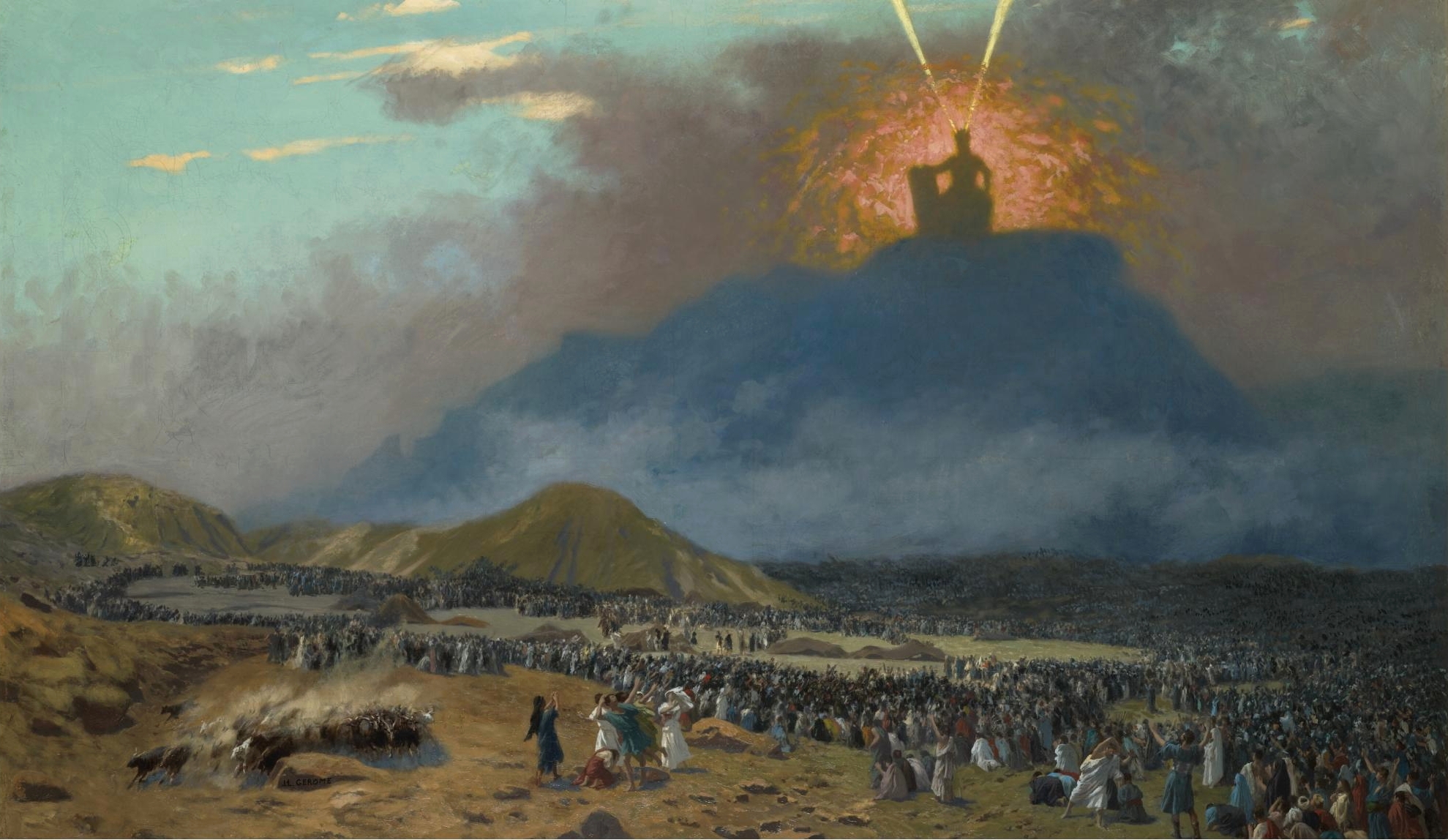
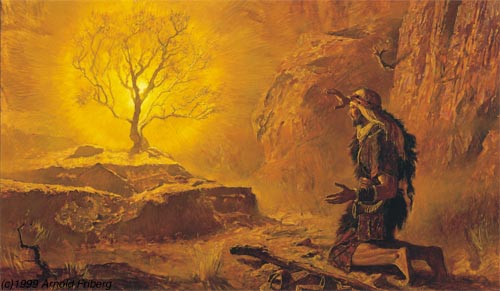
One day, as Moses led his flock to Mount Horeb, he saw a bush burning without being consumed. When he turned aside to look more closely at the marvel, God spoke to him from the bush revealing his name to Moses.
In the time of Emperor Constantine, Mount Horeb was identified with Mount Sinai, but scholars think it was located much farther north.
God also commissioned him to go to Egypt and deliver his fellow Hebrews from their bondage. He then returned to Egypt.
Moses was met on his arrival in Egypt by his elder brother, Aaron, and gained a hearing with his oppressed brethren. It was a more difficult matter, however, to persuade Pharaoh to let the Hebrews depart. This was not accomplished until God sent ten plagues upon the Egyptians.
These plagues culminated in the slaying of the Egyptian first-borns whereupon such terror seized the Egyptians that they ordered the Hebrews to leave.
The long procession moved slowly, and found it necessary to encamp three times before passing the Egyptian frontier - some believe at the Great Bitter Lake, while others propose sites as far south as the northern tip of the Red Sea.
Meanwhile, Pharaoh had a change of heart, and was in pursuit of them with a large army. Shut in between this army and the sea, the Israelites despaired, but God divided the waters so that they passed safely across on dry ground. When the Egyptian army attempted to follow, God permitted the waters to return upon them and drown them.
Following this, according to the last chapters of Exodus, the Tabernacle was constructed, the priestly law ordained, the plan of encampment arranged both for the Levites and the non-priestly tribes, and the Tabernacle consecrated. As the Bible next describes, Moses then led the Israelites to Mount Sinai, where God gave them the Ten Commandments and other laws contained in the Torah.
Through these laws, God is said to have established a covenant with the Israelite people. The Israelites pledged to follow God's laws, and God promised to be their God forever.
These laws were intended to establish the moral principles by which the new Israelite nation would govern itself and through which it would manifest God's hope for just and right relationships among people.
When Moses first came down from Mount Sinai he saw that many of the Israelites had made an image of a calf out of gold, which they were worshiping. In his anger, Moses smashed the tablets containing the Ten Commandments.
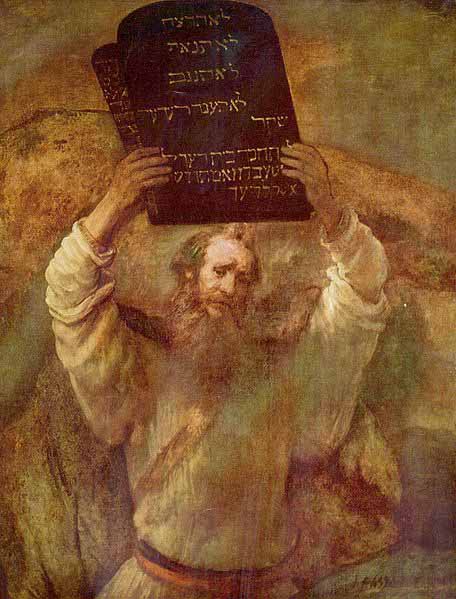
God was prepared to abandon the people for the sin of idolatry, but Moses interceded on their behalf. Soon after, he went back up Mount Sinai and was given a second set of the Ten Commandments.
Moses next prepared to lead the people from Mount Sinai to the promised land of Israel. However, the Israelite people, accustomed to slavery and uncertain of freedom, soon rebelled against God.
They became convinced that they could not conquer the new land, and they constantly questioned Moses' leadership and their own faith in God.
As a consequence, the generation that left Egypt was not allowed to enter the promised land. The Bible describes Moses as once losing patience with the people and seeming to doubt God: rather than speaking to a rock to get water as God commanded, Moses struck the rock with his staff. For this, Moses was also destined not to enter the new land.
Near the end of his life, Moses taught the laws of the Torah to the new generation that had grown up in the desert. He then transferred leadership to Joshua.
The Torah ends with Moses' final blessing to the people, after which he ascended Mount Nebo, which is identified with Mount Pisgah, on the eastern edge of the Jordan River. Moses died there, able to see, but not to enter, the promised land.
There is a wealth of stories and additional information about Moses in the Jewish genre of rabbinical exegesis known as Midrash, as well as in the primary works of the Jewish oral law, the Mishnah and the Talmud.
For Christians, Moses -- mentioned more often in the New Testament than any other Old Testament figure -- is often a symbol of the contrast between traditional Judaism and the teachings of Jesus. New Testament writers often made comparison of Jesus' words and deeds with Moses' in order to explain Jesus' mission. In the book of Acts, for example, the rejection of Moses by the Jews when they worshipped the golden calf is likened to the rejection of Jesus, also by the Jews.
Moses also figures into several of Jesus' messages. When he met the Pharisee Nicodemus at night in the third chapter of John, he compares Moses' lifting up of the bronze serpent in the wilderness, which any Israelite could look upon and be healed, to his own lifting up (by his death and resurrection) for the people to look upon and be healed. In the sixth chapter, Jesus responds to the people's claim that Moses provided them manna in the wilderness by saying that it was not Moses, but God, who provided. Calling himself the "bread of life", Jesus states that he is now provided to feed God's people.
Moses is also regarded as a symbol of the law, and so he is presented in all three Gospel accounts of the Transfiguration in Matthew 17, Mark 9, and Luke 9, respectively.
Members of the Church of Jesus Christ of Latter-Day Saints acknowledge Moses as a prophet and as the great law-giver for Israel. Latter-Day Saints believe that in 1836 Moses appeared to Joseph Smith, Jr. at the Kirtland Temple in Kirtland, Ohio and gave him the keys for the gathering of the Twelve Tribes of Israel.
Doctrine and Covenants, Section 110; Verse 11: "After this vision closed, the heavens were again opened unto us; and Moses appeared before us, and committed unto us the keys of the gathering of Israel from the four parts of the earth, and the leading of the ten tribes from the land of the north."
Baha'i's believe that Moses was a "Manifestation of God," or one in a line of prophets who have revealed the Word of God progressively for a gradually maturing humanity.
In this way, Moses shares an exalted station with Abraham, Krishna, Buddha, Zoroaster, Jesus, Muhammad, the Bab, and the founder of the Baha'i Faith, Baha'u'llah. Baha'i scripture often refers to Moses using the traditional Islamic designation "He who conversed with God."
It has been traditionally assumed that Moses received from God and subsequently transcribed all, or almost all, of the Torah, and this is still the view of most Christians and most of Orthodox Judaism. However, many liberal scholars, following the practice of higher criticism have become convinced that this work, in the form we know it today, was edited together from several earlier sources. This idea is discussed in the entry on the documentary hypothesis.
Around the end of the Hyksos era
About 1420 BC, since records exist of "Habiru" invasions of Canaan forty years later - this theory fits well the modern idea that the historical persona of Moses was the early 15th century BC Crown Prince of Egypt called Ramose, who also disappeared from Egyptian records around the time of Queen Hatshepsut's death;
During the 13th century BC, as the pharaoh during most of that time, Rameses II, is commonly considered to be a pharaoh with whom Moses squabbled - either as the 'Pharaoh of the Exodus' himself, or the preceding 'Pharaoh of the Oppression' who is said to have commissioned the Hebrews to "(build) for Pharaoh treasure cities, Pithom and Raamses." These cities are known to have been built under both Seti I and Rameses II, possibly making his successor Merneptah 'Pharaoh of the Exodus.' This is considered plausible by those who view the famed stele of Merneptah's 5th year (ca. 1208 BC), claiming that "Israel is wasted, bare of seed", as propaganda covering up his own loss of an army in the sea.
A more recent and controversial view places Moses as a noble in the court of the Pharaoh Akhenaten. Many scholars from Sigmund Freud to Joseph Campbell suggest that Moses may have fled Egypt after Akhenaten's death (ca. 1358 BC) when much of the pharaoh's monotheistic reforms were being violently reversed. The principal ideas behind this theory are: the monotheistic religion of Akhenaten being a possible predecessor to Moses' monotheism, and a contemporaneous collection of "Amarna Letters" written by nobles to Akhenaten (Amarna was Akhenaten's capital city) which describe raiding bands of "Habiru" attacking the Egyptian territories in Mesopotamia. (Transformations of Myth Through Time, Joseph Campbell, p. 87-90, Harper & Row)
Finally, there is the challenge of interpreting the many miracles in the Moses story. Most of them are simply dismissed by scholars as legends, but some can be explained. For example, some of the plagues strongly resemble exaggerated versions of actual pestilences common in the ancient world, the famous Red Sea crossing may have been a marsh (the "Reed Sea") through which the Egyptian chariots could not penetrate, the manna which God bestowed on the hungry Israelites may have been the secretion of the hammada shrub, and the swallowing of Korah (Numbers 16) could have been an earthquake.
There is also a psychoanalytical interpretation of Moses' life, put forward by Sigmund Freud in his last book, Moses and Monotheism, in 1937. Freud postulated that Moses was an Egyptian nobleman who adhered to the monotheism of Akhenaten. Freud also believed that Moses was murdered in the wilderness, producing a collective sense of patricidal guilt which has been at the heart of Judaism ever since. "Judaism had been a religion of the father, Christianity became a religion of the son," he wrote.
A recent alternative suggestion resulting from interpreting Biblical and Egyptian history (by Egyptologist Ahmed Osman) proposes that Moses and Akhenaten are the same person (Moses and Akhenaten, Dec. 2002). Opponents of this view point to the fact that the religion of the Torah seems very different to Atenism in everything except the central feature of devotion to a single god.
Several professors of archaeology claim that many stories in the Old Testament, including important chronicles about Moses, Solomon, and others, were actually made up for the first time by scribes hired by King Josiah (7th century BC) in order to rationalize monotheistic belief in Yahweh; and that no surviving written records from Egypt, Assyria, etc., refer to the stories of the Bible or its main characters before 650 BC.
Such claims are detailed in Who Were the Early Israelites? by William G. Dever (William B. Eerdmans Publishing Co., Grand Rapids, MI, 2003). Another such book by Neil A. Silberman and colleagues is The Bible Unearthed (Simon and Schuster, New York, 2001).
Traditionalists point out that many of the details of the Pentateuch are consistent with the time period, such as the price of a slave (30 shekels as opposed to around 60 at the time of the Babylonian captivity), the practice of blood covenants and the discovery of what appear to be chariot wheels on the bottom of the Red Sea. Skeptics view most of these as inconclusive or otherwise consequential.
If the Bible gives an accurate description of Moses' views, then by "modern standards" some of his commands might amount to calls for murder, war crimes or slavery. For instance, according to Numbers 31:15-18, he called for the massacre of boys and the enslavement of female children to Israelite veterans of the Midian war ("kill every male among the little ones, and kill every woman that hath known man by lying with him. But all the little girls among the women, that have not known a man by lying with him, keep alive for yourselves").
For those Jews who practice Judaism, as well as some Christians, the five books of Moses are holy books revealed by God, and the message within them is eternal. For Unitarian Universalists, and other liberal movements, it is regarded as a sacred text, but not as a divinely revealed work. Adherents of all these faiths understand the serious ethical dilemmas that arise when reading certain parts of the Bible. As such, Jews and Christians have developed a number of responses to understanding such texts. There are two basic positions that one can assume when approaching such texts, both of which offer a variety of responses.
One using the traditional approach was originally called a fundamentalist. The fundamentalist term has evolved to reflect other meanings however, including that of "a person with an unthinking devotion to an agenda without regard to reason." The traditional approach assumes that Biblical characters, the situations described, and the words said took place as the Bible says. The Bible is believed to be divinely revealed truth, unique among historical texts.
This view does not exempt humans from a carefully reasoned examination of the scriptures, however, and in fact requires it. Translation, historical context and assumptions, and the definition and applicability of terms used in the original text not only affect what the Bible "says," they define it.
A fundamentalist may believe there is one valid source (organization, person, etc.) for the interpretation of the "truths" of the Bible. The traditional Christian view implies however that a "literal interpretation of the Bible" is an oxymoron.
The important characteristic of the traditional Christian view comes from the Bible itself--that scripture is useful in the context of personal applicability (2 Timothy 3:16-17). Thus, blind adherence to an organization's or one's own static interpretation is rejected in this view, as devotion to the "living" God prohibits devotion to a static ideology.
The traditional Christian view implies that the Bible is unique among texts in its truthful nature (lack of falsehood), while simultaneously implying that truth is meaningful only in living application through a personal relationship to God - attempting to adhere to a static set of moral laws is believed to lead to death (see, ie, Romans 7).
The traditional Christian believes one arrives at this view by "answering the call of God," who speaks to all mankind through revelation, where revelation is never contradictory and consists of both the Bible and experience gained through life.
When faced with an ethical dilemma in Moses's writings, a traditional Christian might employ critical examination of available historical context, critical examination of how the writing should be translated, and critical examination of his or her understanding of God's nature to determine what the passage means, all the while believing the Bible contains no falsehood.
For an example of this process applied to the Midian war, see this exploration of Moses's writing from a traditional Christian point of view: Moses and the Midianites. Moses, in the traditional Christian view, was considered a good man not because of his ethics, but because of his trust in God.
In this view, only Jesus was a good man for what he did, the rest of mankind (including Moses and his contemporaries) can only become good by believing and trusting God. Traditional Christianity believes that one who honestly looks for God will find God, as this is stated in the Bible, and that honest, rational exploration yields the Bible as the most rational explanation for human experience.
Liberal Christian denominations and congregations reject this view. They hold that the texts of the Bible were edited together from a number of sources over a long period of time, and the authorship and timing of the Torah is debated. In this view, the situations described in the Bible do not necessarily represent divinely inspired truth but instead represent the views of the editors of the Bible.